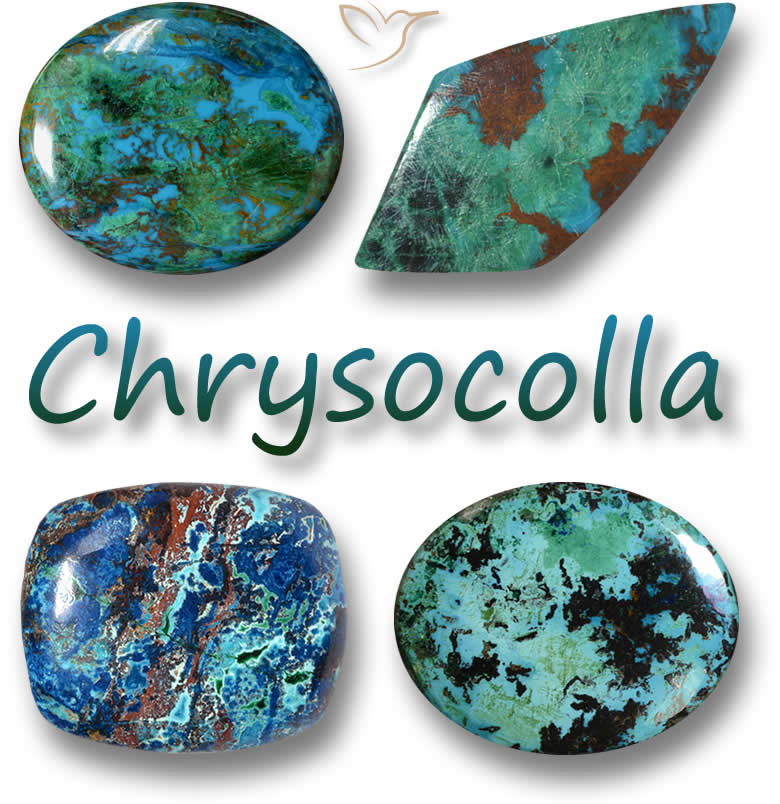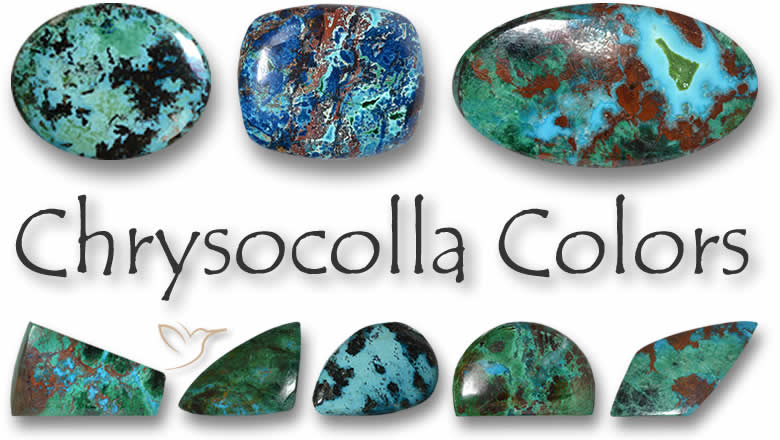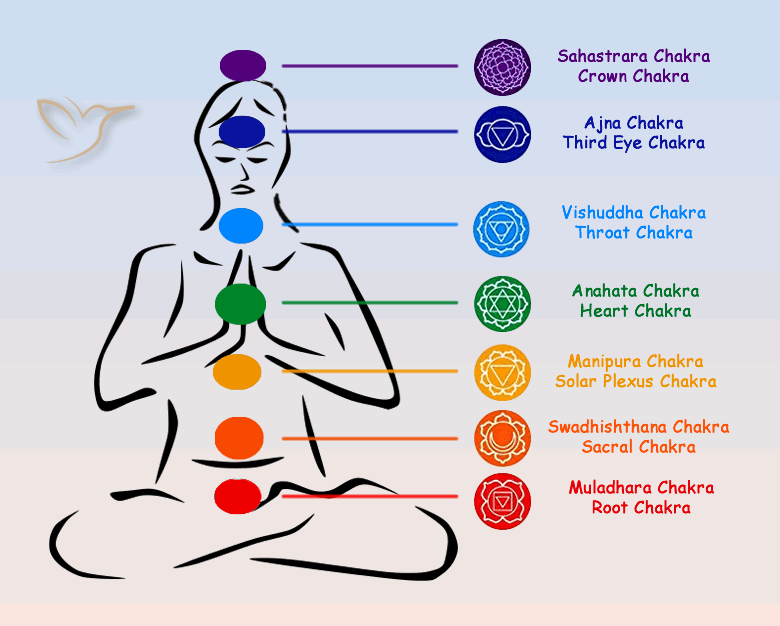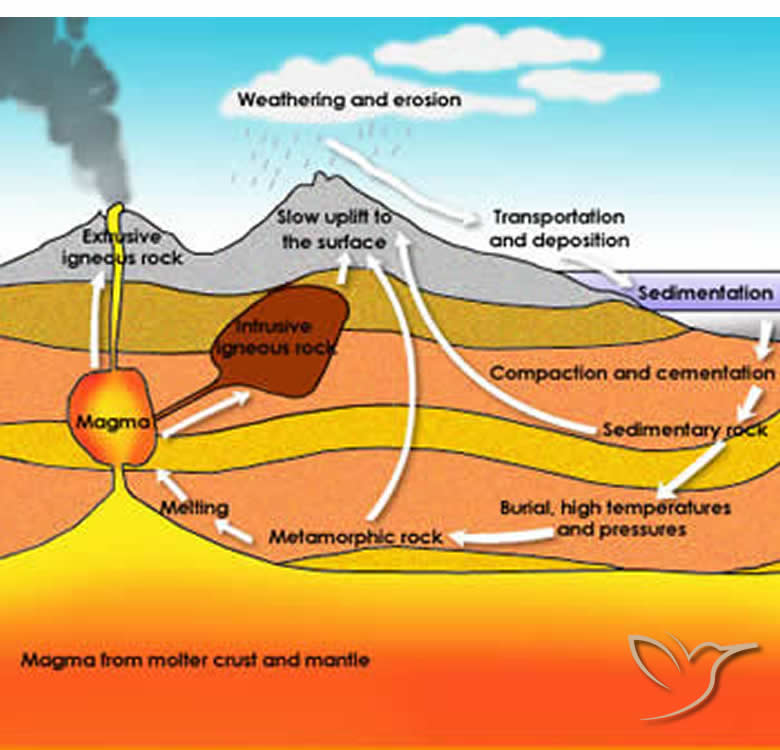What can I find in this article?
- Chrysocolla Colors
- Chrysocolla Species
- Chrysocolla Clarity and Cut
- Spiritual Meaning of Chrysocolla
- Chrysocolla and the Chakras
- Health Benefits of Chrysocolla
- Chrysocolla Price
- Chrysocolla Discovery
- Where is Chrysocolla found?
- How is Chrysocolla formed?
- Can Chrysocolla be treated?
- What jewelry is Chrysocolla suitable for?
- How to care for Chrysocolla
- How to tell a real Chrysocolla
- Can Chrysocolla change color?
- What is so special about Chrysocolla
- Chrysocolla - Gemological Properties
Chrysocolla Gemstone Information

Introduction
Chrysocolla is not a very well-known gemstone but is becoming steadily more and more used to make interesting modern jewelry items such as wire-wrapped pendants because of its intricate patterns, rich green and blue colors and availability in large sizes and offbeat shapes.
In addition to being used as jewelry, Chrysocolla is also very popular among gemstone collectors for its eye-catching and complex appearance as well as those who appreciate and understand its spiritual powers and benefits.

The most sought after, and therefore expensive, Chrysocolla gemstones are the bright blue or green ones with turquoise and teal being the favored hues. The color is caused by the presence of copper in the mineral composition of the gemstone when forming.
Chrysocolla is very rarely found in its purest blue or green form – it would be too soft and crumbly – but is usually mixed up with other minerals such as quartz, chalcedony and even opal. This combination not only makes it a bit more durable but also adds other swirls and patches of color and pattern to enhance the gemstone’s looks.
Chrysocolla itself is a copper silicate and on its own is an unusual material, not really a mineral more a silica gel which has hardened over time. It is often formed with other minerals such as chalcedony, turquoise, malachite or quartz which makes for interesting colors and patterns and makes it hard enough to be used as a gemstone.
Varieties include:
- Eilat Stone - A greenish blue version of Chrysocolla with naturally added turquoise and malachite mined in southern Israel.
- Stellarite – A light blue gemstone made up of Chrysocolla and Quartz, sometimes simply called Chrysocolla Quartz.
- Parrot Wing – a mix of Chrysocolla and Jasper which is a greenish brown color.
- Gem Silica – This is sometimes called Chrysocolla Chalcedony and is a rare and valuable gemstone but not really part of the Chrysocolla family just colored by the same copper mineral.
Chrysocolla is what we call a cryptocrystalline material which, like agate, jasper, carnelian and onyx to name but a few is made up of microscopic crystals, too small to see with the naked eye. These types of gemstones tends to be opaque and are made up of a mixture of material giving them interesting color patterns and a rocky appearance.
In contrast we have macrocrystallines such as quartz, amethyst and citrine which have large crystals, tend to be translucent or transparent and are a bit harder.

Chrysocolla is classed as an opaque gemstone although with the appearance of other materials and recent silicified finds some can be almost translucent.
The clarity of gemstones is basically how well we can see through the body of the stone and if there are any flaws or blemishes inside – known as inclusions in the gems trade.
Gemstones can be transparent, meaning objects can be identified or words read quite easily when looking through the gemstone.
Or they can be translucent where light can shine through but we cannot make out shapes or images very well.
Lastly there are opaque gemstones in which light cannot pass through even when holding the gemstone up to a torch light or the sun.
Clarity can be graded from being flawlessly transparent to opaque with various grades along the way.
Chrysocolla are nearly always cut and polished in to dome shaped cabochons. They are usually oval shaped but these days you can find squares, pears and free form shapes ideal for one-of-a-kind jewelry items.
Chrysocolla has been in use by man for thousands of years and got its name around 300 BC when the Ancient Greek philosopher and botanist, Theophrastus, noticed its resemblance to a borax based material which was used as a flux for welding gold pieces – Chryso (gold) colla (glue).
Around the same time Ancient Egyptians would bury Chrysocolla amulets with Mummified children suggesting that it was considered a protective stone for children.
Cleopatra was said to have carried Chrysocolla when negotiating with her brother or the Romans as it calmed hotheadedness and allowed her and her opponents to retain their composure.
In a similar vein, Chrysocolla, is renowned as a communication gemstone, both for speaking and listening making it perfect for teachers and anyone who has to give speeches for a living. We would recommend taking a Chrysocolla gemstone to meetings or conferences.
Wise women, folk healers, midwives and grandmothers have a special affinity with Chrysocolla. It helps them pass on their knowledge to the younger generations and allow the accumulated learning and wisdom to continue to help.
Maintaining this theme, Chrysocolla has feminine energy, honoring the Greek Goddess, Sophia, promoting wisdom, tranquility and nurture.
Chakra is a word meaning wheel or circle from the Ancient Hindu philosophy and applies to the energy centers found in the body also referred to as Qi or Prana in other cultures. There are seven Chakras points throughout the body each regulating a different physical, emotional or mental state.

These are the Crown, Third Eye, Throat, Heart, Solar Plexus, Sacral and Root. Each chakra is correlated to a color of influence and a gemstone which has a particularly dominant color will often be connected with that color’s chakra point.
Sometimes our Chakras get out of alignment or blocked and need to be realigned or cleansed. One way to do this is by the use of Chakra healing stones. These stones or crystals are usually colored to correspond to individual chakras, red for the Root Chakra, orange for the Sacral, yellow for the Solar Plexus, green for the Heart, blue for the Throat, Indigo for the Third Eye and purple for the Crown Chakra.
Chrysocolla’s predominantly blue and green colors suggest an influence on the Throat Chakra and this backs up other cultures’ association of Chrysocolla with communication. A blocked Throat Chakra can manifest itself physically in the form of a sore throat or a neck and shoulder pain or metaphysically with a fear of public speaking or a worry about an upcoming conversation.
Chrysocolla can help unblock or realign your throat chakra by either lying down with a gemstone placed at the base of your throat, then relaxing with regulated breaths or just by wearing a Chrysocolla pendant or necklace throughout the day.
On a physical level, Chrysocolla can alleviate sore throats, thyroid issues, laryngitis and any problems with the larynx in general. High blood pressure, blood circulation complications, menopause, PMS, childbirth and nervous disorders can also benefit from the presence of Chrysocolla.
We are certainly not authorities in these matters but we have gained some experience and knowledge from our years of selling spiritually powerful gemstones and getting feedback from many of our customers. When we are asked how to use gemstones for spiritual or health benefits we have a few suggestions.
Of course, wearing a gemstone as a piece of jewelry is the easiest way for the crystal to influence your body and putting one in your handbag or pocket where it can be easily used as a touchstone is a good alternative.
When meditating, place a gemstone in the palm of your hand or put one beside you on the floor. If you do not meditate, just lay down with crystals on your body, lined up with the chakra points if possible.
Take a bath with the gemstone in the water or on the edge of the tub (check the particular stone is okay in water).
Chrysocolla crystals boost the working place and are said to protect computers and mobile phones so keep one on your desk.
To cleanse a Chrysocolla gemstone, hold it under running water, a spring or stream is ideal but a tap will do, then dry it in the sun for a half an hour or so. Chrysocolla can be a bit delicate so do not try anything that could be too rough or damaging.

Chrysocolla Price List |
||
| Color | Weight range | Price range / USD |
|---|---|---|
Multicolor |
1ct + |
$0.5 - $5/ct |
Color decides the price of Chrysocolla. Whether it veers towards the green or the blue side of the spectrum, a nice even coloring across the surface of the gemstone is valued the highest. There will be veins or patches of other colors but if this creates interesting patterns or shapes this can enhance the price and not detract.
It is generally an opaque gemstone so just look out for a nicely polished surface with a glassy finish free from chips or cracks.
The shape will usually be ovals or rounds or sometime pear outlines but modern cutters are beginning to cut interesting shapes to make the most of patterns and colors found in this intriguing gemstone.
Chrysocolla are sold by the carat but we suggest buying this type of gemstone by its physical dimensions so you know exactly what you are getting. This gemstone can come in some large sizes and, of course, all things being equal, the bigger the size, the bigger the price.
With its interesting patterns and bright blue and green colors, Chrysocolla is a lovely gemstone yet it is not particularly expensive. As a display gemstone or made into an item of jewelry it is sure to get some admiring looks.

Chrysocolla has been used by man for thousands of years and its earliest known source was the mines of southern Israel near present day Eilat in the Gulf of Aqaba. It was for a time called the King Solomon Stone after the famous ruler of Ancient Israel and legend has it that the earliest Chrysocolla came from the lost King Solomon’s Mines of Africa.
It was first written about in 315 BC by Greek philosopher, Theophrastus, and, as it is a relatively soft gemstone, it was commonly carved in Ancient Greece and Rome. Mummified Egyptian children have often been found with Chrysocolla amulets tied to their arms as some sort of protection for the journey to the afterlife.
The father of medicine, Hippocrates wrote of the curative powers of Chrysocolla and in the Middle Ages it was used by doctors to clean wounds and treat eye pain.
Chrysocolla resembles both turquoise and malachite and has often been used instead of both these gemstones. Incan, Aztec and native North American tribes used both Chrysocolla and turquoise in decorative, ceremonial and spiritual ways.

Chrysocolla occurs throughout the world with significant producers including the USA and Mexico in North America, Chile and Peru in South America, Australia, Russia and, probably most famously and historically, in Israel.

Chrysocolla is made up of Oxygen, Copper, Silica, Aluminum and Hydrogen and is called a copper silicate. This combining of different materials occurs during formation.
Chrysocolla is a secondary mineral of copper, meaning it was formed when copper minerals were changed by other chemicals. This usually happens when water containing carbon dioxide seeps through the copper leeching the various chemicals with it until they gather in cracks and fissures and harden.
This basic material is usually mixed up with other minerals such as quartz, chalcedony, malachite, turquoise, azurite, often two or three types so its chemical composition is difficult to determine.
As far as we are aware Chrysocolla is not treated in any way other than the usual cutting and polishing into cabochon shaped gemstones.
Chrysocolla can be very brittle and crumbly when it is too ‘pure’, it needs some other material such as quartz to strengthen it. If the rough gemstone is all blue or green it can be very difficult to cut and polish.
We have heard stories about these gemstones being treated with epoxies to stabilize and harden them up enough to sell. We do not stock these versions of Chrysocolla and would disclose any type of treatment our gemstones undergo.
Chrysocolla is rated at 2 - 4 on Mohs hardness scale which is quite low among gemstones so a great deal of care should be taken if making into jewelry. Protective settings are a must and rings and bracelets are likely to be chipped or broken eventually.
See our detailed article on the Mohs hardness scale here
That being said, Chrysocolla is often an amalgam of several minerals and crystals which can be rated much higher on the hardness scale – quartz is 7 for example.
Chrysocolla is an ideal gemstone for interesting and unique pendants or necklaces. They come in nice big sizes, a variety of shapes with cool colors and fascinating patterns. These large sizes, in the correct setting, should be strong enough for daily wear.
Chrysocolla is definitely amongst the weakest of gemstones so extra care must be taken when storing and wearing. Protective settings for any jewelry are a very good idea and storing them separately from other harder gemstones will save them from potential damage, too.
Chrysocolla is especially sensitive to acids and solvents as well as high heat so clean them gently with a soft brush in luke warm soapy water and dry with a cloth.

Buying a certified gemstone from a reputable dealer is the best guarantee of getting a legitimate gemstone but this is not always easy when you are searching the internet or gem stores for a great example or a bargain!
Before buying a Chrysocolla gemstone, familiarize yourself with its appearance. You are looking for a gemstone in various shades of greenish-blue with veins, lines and patches of brown, black, red or yellow. It will have a bit of a shine when polished and is usually quite a substantial size.
Chrysocolla is not a very expensive gemstone but you should be wary of anything really cheap. If the price is too good to be true it usually is!
The hardness of gemstones can often be your first guide but Chrysocolla can be a bit tricky. Its rating is only 2 – 4 on the Mohs scale so it could be scratched by a copper coin or even a hard fingernail in some cases. However the appearance of some quartz or turquoise in the gemstone will affect the hardness.
This has not been a comprehensive guide on how to make sure your Chrysocolla gemstone is 100% genuine but I hope it helps.
At GemSelect, we currently offer brief identification reports from your choice of two well-respected independent gemological laboratories, The Asian Institute of Gemological Sciences (AIGS) and Burapha Gemological Laboratory (BGL Lab).

Some gemstones show a distinct or dramatic change in color depending on the light source. Look at Alexendrite under artificial or electric light and it could look red, take it outside into the daylight and suddenly it is green! This does NOT occur in Chrysocolla gemstones.
Take a good look at a Chrysocolla gemstone and you will soon be fascinated by the colors and patterns that fill the surface.
Some look like satellite maps of earth with forests, rivers, deserts and lakes all clearly visible.
Others have the appearance of abstract paintings with daubs of bright colors on deep green backgrounds where the artist has used brushes, knives, fingers and feathers to create the intricate contours and shadows.
All make unique additions to anyone’s collection of rare gemstones or ideal components of striking and original items of jewelry.
Chemical Formula: |
(Cu,Al)2H2Si2O5(OH)4nH2O Hydrous copper silicate |
Crystal Structure: |
Orthorhombic - monoclinic, botryoidal |
Color: |
Green, blue, bluish-green, blackish-blue, brown, multicolor |
Hardness: |
2 to 4 on the Mohs scale |
Refractive Index: |
1.460 to 1.570 |
Density: |
2.00 to 2.40 |
Cleavage: |
None; fracture: conchoidal |
Transparency: |
Opaque; sometimes near translucent |
Double Refraction or Birefringence: |
-0.023 to -0.040 |
Luster: |
Greasy, vitreous |
Fluorescence: |
None |
- العربية | معلومات الكريزوكولا - البلوز والأخضر الساطع مع أنماط حية
- 中文 | Chrysocolla 信息 - 明亮的蓝色和绿色,带有生动的图案
- Français | Informations sur le chrysocolle - Des couleurs bleues et vertes au...
- Deutsch | Chrysokoll Info - Helle Blau- und Grüntöne mit lebendigen Mustern
- Italiano | Chrysocolla Info - Azzurri e verdi accesi con motivi vivaci
- 日本語 | ChrysocollaInfo-鮮やかなパターンの明るい青と緑
- 한국인 | Chrysocolla Info - 생생한 패턴의 밝은 파란색과 녹색
- Português | Chrysocolla Info - Azuis e verdes brilhantes com padrões vivos
- Pусский | Chrysocolla Info - Яркие синие и зеленые тона с живыми узорами.
- Español | Información sobre la crisocola - Azules y verdes brillantes con pa...






